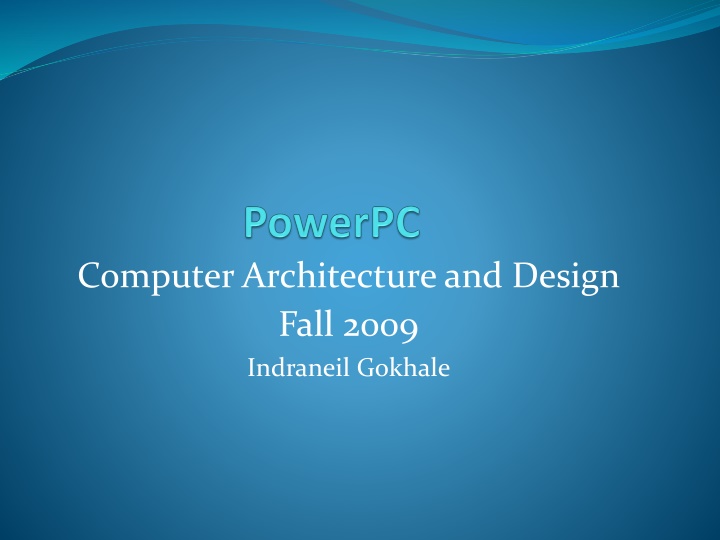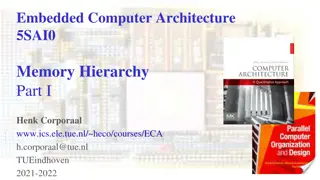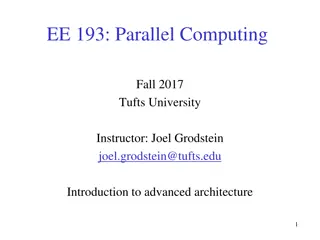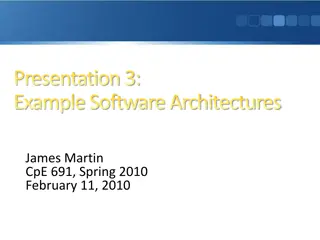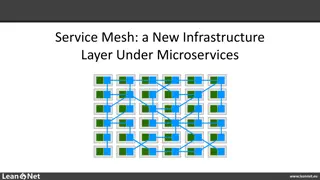PowerPC Architecture Overview and Evolution
PowerPC is a RISC instruction set architecture developed by IBM in collaboration with Apple and Motorola in the early 1990s. It is based on IBM's POWER architecture, offering both 32-bit and 64-bit processors popular in embedded systems. The architecture emphasizes a reduced set of pipelined instructions for efficient throughput. The PowerPC architecture saw significant contributions from IBM, Apple, and Motorola, leading to advancements in RISC design and chip fabrication. The evolution of PowerPC added features like single-precision floating-point instructions and general register-to-register operations. Presently, PowerPC processors are used in various applications ranging from embedded systems to high-performance computing.
Download Presentation

Please find below an Image/Link to download the presentation.
The content on the website is provided AS IS for your information and personal use only. It may not be sold, licensed, or shared on other websites without obtaining consent from the author.If you encounter any issues during the download, it is possible that the publisher has removed the file from their server.
You are allowed to download the files provided on this website for personal or commercial use, subject to the condition that they are used lawfully. All files are the property of their respective owners.
The content on the website is provided AS IS for your information and personal use only. It may not be sold, licensed, or shared on other websites without obtaining consent from the author.
E N D
Presentation Transcript
Computer Architecture and Design Fall 2009 Indraneil Gokhale
Introduction POWER is a RISC instruction set architecture designed by IBM. The name is a ackronym for Performance Optimization With Enhanced RISC Created by the 1991 Apple-IBM-Motorola alliance, known as AIM. PowerPC is largely based on IBM's POWER architecture, and retains a high level of compatibility with it; the architectures have remained close enough that the same programs and operating systems will run on both if some care is taken in preparation. 32-bit and 64-bit PowerPC processors have been a favorite of embedded computer designers. To keep costs low on high-volume competitive products, the CPU core is usually bundled into a system-on-chip (SOC) integrated circuit.
RISC VS CISC CISC RISC MUL 2:3,5:2 LOAD A, 2:3 LOAD B, 5:2 PROD A, B STORE 2:3, A RISC relatively few number of Pipelined Instructions to achieve a high throughput on each clock pulse.
AIM Contributions IBM - Record Breaking RISC Architecture APPLE - Pink Operating System to Run on the POWERPC MOTOROLA Chip Designers and Submicron Chip Fabrication Plant.
What They Gained !!! IBM - merchant semiconductor market they were looking for. APPLE - got to use one of the most powerful RISC CPUs on the market, and massive press buzz due to IBM's name. MOTOROLA - got an up-to-date RISC chip, and help with design methodology from IBM. (Motorola already had its own RISC design in the form of the 88000 which was doing poorly in the market)
PowerPC and Power Architecture The PowerPC architecture is a modified version of the POWER architecture. The PowerPC architecture added: Single-precision floating point instructions. General register-to-register multiply and divide instructions. Removed some POWER features such as the specialized multiply and divide instructions using the MQ register. It also added a 64-bit version of the architecture. PowerPC 600 family, PowerPC 700 family, PowerPC 900 family, PowerPC 400.
Current Status PowerPC e200 - 32 bit power architecture microprocessor - speed ranging up to 600 MHz - ideal for embedded applications. PowerPC e300 similar to e200 with an increase in speed upto 667 MHz. PowerPC e600 speed upto 2 Ghz ideal for high performance routing and telecommunications applications. POWER5 IBM dual core P POWER6 IBM Dual core P - A notable difference from POWER5 is that the POWER6 executes instructions in-order instead of out-of-order PowerPC G3 - Apple Macintosh computers such as the PowerBook G3, the multicolored iMacs, iBooks and several desktops, including both the Beige and Blue and White Power Macintosh G3s. PowerPC G4 - is a designation used by Apple Computer to describe a fourth generation of 32-bit PowerPC microprocessors. PowerPC G5 - 64-bit Power Architecture processors Cell is a microprocessor architecture jointly developed by Sony Computer Entertainment, Toshiba, and IBM PS3 game console Xenon - based on IBM s PowerPC ISA XBOX 360 game console. Broadway based on IBM s PowerPC ISA Nintendo Wii gaming console Blue Gene/L - dual core PowerPC 440, 700 MHz, 2004 Blue Gene/P - quad core PowerPC 450, 850 MHz, 2007
MPC601 Architecture Fixed length 32-bit wide Instructions 3 parallel execution units Branch Processing Unit Interger Unit Floating Point Unit Instructions are dispatched to the different execution units via an Instruction Unit, which can queue up to 8 instructions and has a dedicated adder for prefetching.
Instruction Queue and Dispatch Logic It is Fed by eight-word bus from the cache. During each cycle, the dispatch logic considers the bottom four entries of the instruction queue and dispatches up to three instructions.
Future Technologies: POWER7 - currently under development at about a dozen IBM sites including IBM's Rochester, Austin and B blingen laboratories as of April 2006. The POWER7 is the successor to POWER6 and will be released in mid-2010. PowerPC e700 or NG-64 (Next Generation 64-bit) a line of future high performance 64-bit embedded RISC-processor cores built using Power Architecture technology designed by Freescale. TITAN 32 bit Power Architecture -based microprocessors designed by Applied Micro Circuits Corporation (AMCC)
References A. Marsala and B. Kanawati, PowerPC Processors , Proc. 26th IEEE Southeastern Symp. System Theory, 20-22 March, 1994, pp. 550-556. Michael K. Becker, Michael S. Allen, Charles R. Moore, John S. Muhich, David P. Tuttle, "The Power PC 601 Microprocessor," IEEE Micro, vol. 13, no. 5, pp. 54-68, Sep/Oct, 1993 http://en.wikipedia.org/wiki/PowerPC http://www.experiencefestival.com/a/powerpc%20- %20history/id/5389870
